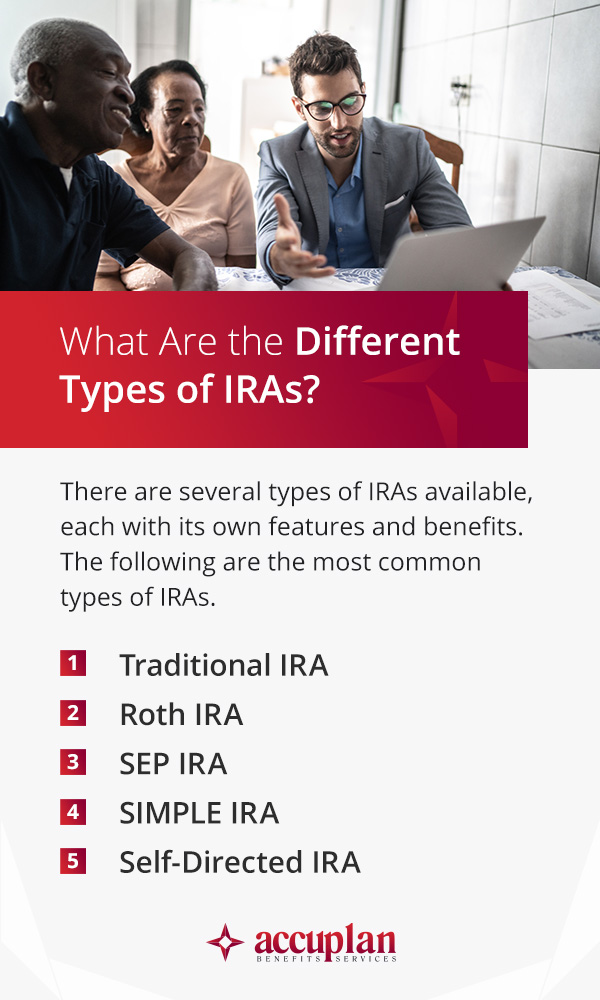
How Many IRAs Can I Have?
If you are saving for retirement, you may be considering opening more retirement accounts. Individual retirement accounts (IRAs) can be a great option if you want to contribute more to your retirement beyond your employer-sponsored plan or if you don’t have a retirement plan through your employer. While there is no exact number regarding how many IRAs one person can have, there are some limits and rules that may affect how much money you can contribute annually.
How Many IRAs Can You Have?
Individuals can have multiple IRAs, but there are certain limits and rules that may apply. For traditional and Roth IRAs, an individual can contribute up to $7,000 per year. However, if you are 50 or older, you can make an additional catch-up contribution of $1,000 for a total contribution of $8,000 per year.
An individual can have multiple traditional and Roth IRAs, but the total contribution across all accounts cannot exceed the annual limit. For example, if you have two traditional IRAs, you can contribute a total of $7,000 across both accounts, but not $7,000 to each account.
There are also other types of IRAs, such as SEP IRAs, SIMPLE IRAs and inherited IRAs, each with its own contribution and distribution rules. You may want to consult with a financial advisor or tax professional to determine the best IRA strategy for your individual circumstances.
How Many IRAs Can a Married Couple Have?
Married couples can each have their own separate IRAs, regardless of whether they file their tax return jointly or separately. In addition to their own IRAs, they may be eligible to contribute to a spousal IRA if one spouse has little or no earned income for the year. For traditional and Roth IRAs, the annual contribution limit is the same for married couples as for individuals. The contribution limit is currently $7,000 per person or $8,000 per person if they are 50 or older.
Each spouse can contribute up to the limit, so a married couple under the age of 50 can contribute up to $14,000, or $7,000 each, to their IRAs in a given year. A married couple over the age of 50 can contribute up to $16,000, or $8,000 each. However, the contribution limit is based on each individual’s earned income, so if one spouse has no earned income, they may not be eligible to contribute to an IRA.

What Are the Different Types of IRAs?
There are several types of IRAs available, each with its own features and benefits. The following are the most common types of IRAs.
1. Traditional IRA
A traditional IRA is a type of retirement account that allows you to contribute pre-tax dollars to the account, potentially lowering your taxable income for the year. The funds in your account grow tax-deferred, which means you don’t pay taxes until you withdraw in retirement.
With a traditional IRA, you may be able to deduct your contributions from your taxable income, depending on your income level and whether you or your spouse are offered a retirement plan via an employer. The contribution limit for traditional IRAs is $7,000 per year for individuals under age 50 and $8,000 per year for those 50 and older.
Withdrawals from a traditional IRA are taxed as ordinary income, and if you withdraw funds before age 59 ½, you may also face a 10% early withdrawal penalty, unless you qualify for an exception. Once you reach age 72 (or 70 ½ if you turned 70 ½ before January 1, 2020), you are required to take minimum distributions from your traditional IRA each year. This is known as a required minimum distribution (RMD).
2. Roth IRA
A Roth IRA allows you to contribute after-tax dollars to the account, meaning you don’t get a tax deduction for your contributions. However, the money in the account grows tax-free, and qualified withdrawals in retirement are also tax-free. When you open a Roth IRA, you may be able to contribute up to $7,000 per year or $8,000 per year if you’re 50 or older. However, there are income limits that determine whether you’re eligible to contribute to a Roth IRA. For 2023, the income limit for single filers is $153,000 and the income limit for married couples filing jointly is $228,000.
One advantage of a Roth IRA is there are no RMDs during the account owner’s lifetime. You can keep the money in the account growing tax-free for as long as you want, and you can even pass the account on to your heirs tax-free.
Another advantage of a Roth IRA is that you can withdraw your contributions at any time, for any reason, without penalty. This can provide some flexibility in case you need to access your savings before retirement. A Roth IRA can be a good option if you expect to be in a higher tax bracket in retirement than you are now or you want to maximize your tax-free retirement income.
3. SEP IRA
A Simplified Employee Pension (SEP) IRA is a type of retirement account that allows self-employed individuals and small business owners to save for retirement. With a SEP IRA, your employer contributes to your account on your behalf and the behalf of other eligible employees, including themselves, if they’re self-employed. The contribution limit for a SEP IRA is up to 25% of an employee’s compensation or $61,000 for 2023, whichever is less.
Contributions to a SEP IRA are tax-deductible, meaning they can reduce the employer’s taxable income. The money in the account grows tax-deferred and withdrawals in retirement are taxed as ordinary income.
One advantage of a SEP IRA is that it’s relatively easy to set up and administer, with no annual filing requirements. However, the employer may need to contribute the same compensation percentage for every eligible employee, including themselves, which can be a disadvantage for businesses with a large number of employees. A SEP IRA can be a good option for small business owners and self-employed individuals who want to save for retirement and potentially reduce their taxable income.
4. SIMPLE IRA
A Savings Incentive Match Plan for Employees (SIMPLE) IRA is a type of retirement account that allows small businesses with up to 100 employees to offer a retirement savings plan to their employees. With a SIMPLE IRA, both the employer and employee can contribute to the account.
Employees can contribute up to $15,500 per year in 2023. Those who are 50 or older may be able to make catch-up contributions of up to $3,500. The employer can either match the employee’s contributions up to 3% of their compensation or contribute 2% of the employee’s compensation to the account. Contributions to a SIMPLE IRA are tax-deductible. The money in the account grows tax-deferred, and withdrawals in retirement are taxed as ordinary income.
One advantage of a SIMPLE IRA is that it’s simple to set up the account and administer it, with no annual filing requirements. However, there are restrictions on when and how much money can be withdrawn from the account before retirement, and early withdrawals before age 59 ½ may be subject to a 10% early withdrawal penalty. A SIMPLE IRA can be a good option for small businesses that want to offer a retirement savings plan to their employees, while also providing some tax benefits to the employer.
5. Self-Directed IRA
A self-directed IRA is a type of IRA that gives you more control over the types of investments held in your retirement account. With a self-directed IRA, you can invest in a wide range of alternative assets beyond traditional stocks, bonds and mutual funds, such as real estate, private equity and precious metals.
The custodian or trustee of the self-directed IRA holds the assets on your behalf, and you direct the custodian or trustee on what investments to make. The custodian or trustee is responsible for ensuring that the investments comply with IRS rules and regulations. Self-directed IRAs can be either a traditional self-directed IRA or a self-directed Roth IRA, meaning that contributions to the account can be tax-deductible or made on a post-tax basis, depending on the type of account.
One advantage of a self-directed IRA is that it can provide more diversification in your retirement portfolio, potentially leading to higher returns. However, self-directed IRAs also come with additional risks, including the potential for investment fraud and the need for you to have a good understanding of the investments you’re making. Additionally, some custodians or trustees may charge higher fees for managing self-directed IRAs.
Each type of IRA has its own contribution limits, eligibility requirements and other rules, so it’s important to consult with a professional to determine which type of IRA is right for you.

Benefits of Having Multiple Retirement Accounts
There are several benefits to having more than one retirement account, including:
- Flexibility: Multiple retirement accounts give you more flexibility in retirement. You can choose which accounts to withdraw money from first based on your tax situation and investment performance. For example, if you have a Roth IRA and a traditional 401(k), you may choose to withdraw from the Roth IRA first to avoid paying taxes on the withdrawals.
- Diversification: Having more than one retirement account can help you diversify your investments and reduce risk. For example, you may have a 401(k) with your employer that invests in stocks and bonds, and a self-directed IRA that you use to invest in real estate or other alternative assets. This can help spread your money across different asset classes, which can reduce the impact of any one investment on your overall portfolio.
- Tax advantages: Different retirement accounts come with different tax advantages, and having multiple accounts can help you take advantage of these benefits. For example, contributions to a traditional 401(k) are tax-deductible, while contributions to a Roth IRA are made with after-tax dollars but grow tax-free. By having both types of accounts, you can benefit from both tax deductions and tax-free growth.
- Employer matches: If you have multiple retirement accounts, you may be able to take advantage of multiple employer matches. For example, if your employer offers a 401(k) match, you can contribute to that account to receive the match and also contribute to an IRA to take advantage of its benefits.
- Higher contribution limits: Each retirement account has its own contribution limit, and having multiple accounts can allow you to contribute more money overall. For example, if you have a 401(k) with a contribution limit of $22,500 and an IRA with a contribution limit of $6,500, you can contribute up to $29,000 in total.
Multiple retirement accounts can also add complexity to your finances, so it’s a good idea to consult with a financial advisor or tax professional to ensure you’re making the most of your retirement savings.

Disadvantages of Multiple Retirement Accounts
There can be some drawbacks to having more than one retirement account. The following are a few potential cons to consider:
- Complexity: Having many different accounts for retirement can add complexity to your financial life. You’ll need to keep track of multiple accounts, contributions and investment strategies, which can be time-consuming and confusing without professional guidance.
- Fees and expenses: Each retirement account may have its own fees and expenses, so having multiple accounts can increase the total amount you’re paying in fees. It’s important to understand the fees associated with each account and consider consolidating accounts if the fees are too high.
- Inconsistent investment strategies: If you open multiple retirement accounts with different investment strategies, it can be difficult to maintain a consistent investment approach across all accounts. This can lead to imbalances in your portfolio and potentially result in lower returns if you don’t have professional guidance.
- RMDs: Once you reach age 72 (or 70 ½ if you turned 70 ½ before January 1, 2020), you are required to take minimum distributions from most retirement accounts each year. Having multiple accounts means you’ll need to calculate and manage multiple RMDs each year, which can be complicated and may result in a higher tax bill.
Weigh the pros and cons of having many different retirement accounts and determine the best strategy for your individual circumstances. Consult with the team at Accuplan to ensure you’re making the most of your retirement savings.
How Many Retirement Accounts Should I Have?
The number of retirement accounts you should have depends on your individual financial situation and retirement goals. Generally, having multiple accounts can provide more flexibility and diversification in your retirement savings, but there is no set number that is right for everyone.
Consider the following factors when determining how many retirement accounts to have:
- Contribution limits: Each account has its own contribution limit, so having multiple accounts can allow you to contribute more money overall. However, it’s important to make sure you’re not over-contributing and exceeding the annual limits.
- Investment options: Different retirement accounts have different investment options. Multiple accounts can allow you to diversify your investments and potentially reduce risk.
- Employer matches: If your employer offers a retirement savings plan with a match, it may make sense to contribute enough to receive the full match and then consider opening additional retirement accounts.
- Fees and expenses: A retirement account may have its own fees and expenses, so opening multiple accounts can potentially increase the amount you’re paying in fees. If the total amount of fees is too high, you may need to consolidate accounts.
- Personal preference: Ultimately, the number of retirement accounts you have should be based on your personal preference and financial goals. Some people prefer to keep all of their retirement savings in one account for simplicity, while others prefer to have multiple accounts for diversification and flexibility.

Open a Self-Directed IRA With Accuplan
A self-directed IRA can allow you to invest in alternative assets and diversify your portfolio. Open a self-directed IRA with Accuplan today.
*Our information shouldn’t be relied upon for investment advice but simply for information and educational purposes only. It is not intended to provide, nor should it be relied upon for accounting, legal, tax or investment advice.